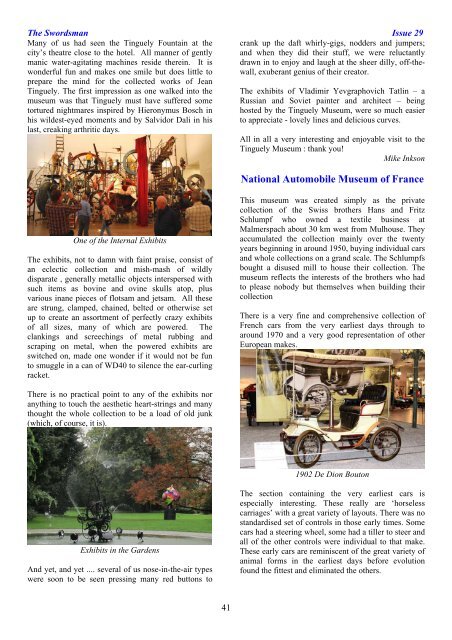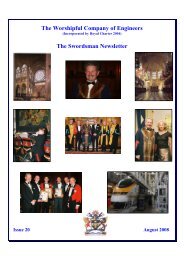The Worshipful Company of Engineers The Swordsman Newsletter ...
The Worshipful Company of Engineers The Swordsman Newsletter ...
The Worshipful Company of Engineers The Swordsman Newsletter ...
You also want an ePaper? Increase the reach of your titles
YUMPU automatically turns print PDFs into web optimized ePapers that Google loves.
<strong>The</strong> <strong>Swordsman</strong> Issue 29<br />
Many <strong>of</strong> us had seen the Tinguely Fountain at the<br />
city’s theatre close to the hotel. All manner <strong>of</strong> gently<br />
manic water-agitating machines reside therein. It is<br />
wonderful fun and makes one smile but does little to<br />
prepare the mind for the collected works <strong>of</strong> Jean<br />
Tinguely. <strong>The</strong> first impression as one walked into the<br />
museum was that Tinguely must have suffered some<br />
tortured nightmares inspired by Hieronymus Bosch in<br />
his wildest-eyed moments and by Salvidor Dali in his<br />
last, creaking arthritic days.<br />
One <strong>of</strong> the Internal Exhibits<br />
<strong>The</strong> exhibits, not to damn with faint praise, consist <strong>of</strong><br />
an eclectic collection and mish-mash <strong>of</strong> wildly<br />
disparate , generally metallic objects interspersed with<br />
such items as bovine and ovine skulls atop, plus<br />
various inane pieces <strong>of</strong> flotsam and jetsam. All these<br />
are strung, clamped, chained, belted or otherwise set<br />
up to create an assortment <strong>of</strong> perfectly crazy exhibits<br />
<strong>of</strong> all sizes, many <strong>of</strong> which are powered. <strong>The</strong><br />
clankings and screechings <strong>of</strong> metal rubbing and<br />
scraping on metal, when the powered exhibits are<br />
switched on, made one wonder if it would not be fun<br />
to smuggle in a can <strong>of</strong> WD40 to silence the ear-curling<br />
racket.<br />
<strong>The</strong>re is no practical point to any <strong>of</strong> the exhibits nor<br />
anything to touch the aesthetic heart-strings and many<br />
thought the whole collection to be a load <strong>of</strong> old junk<br />
(which, <strong>of</strong> course, it is).<br />
Exhibits in the Gardens<br />
And yet, and yet .... several <strong>of</strong> us nose-in-the-air types<br />
were soon to be seen pressing many red buttons to<br />
41<br />
crank up the daft whirly-gigs, nodders and jumpers;<br />
and when they did their stuff, we were reluctantly<br />
drawn in to enjoy and laugh at the sheer dilly, <strong>of</strong>f-thewall,<br />
exuberant genius <strong>of</strong> their creator.<br />
<strong>The</strong> exhibits <strong>of</strong> Vladimir Yevgraphovich Tatlin – a<br />
Russian and Soviet painter and architect – being<br />
hosted by the Tinguely Museum, were so much easier<br />
to appreciate - lovely lines and delicious curves.<br />
All in all a very interesting and enjoyable visit to the<br />
Tinguely Museum : thank you!<br />
Mike Inkson<br />
National Automobile Museum <strong>of</strong> France<br />
This museum was created simply as the private<br />
collection <strong>of</strong> the Swiss brothers Hans and Fritz<br />
Schlumpf who owned a textile business at<br />
Malmerspach about 30 km west from Mulhouse. <strong>The</strong>y<br />
accumulated the collection mainly over the twenty<br />
years beginning in around 1950, buying individual cars<br />
and whole collections on a grand scale. <strong>The</strong> Schlumpfs<br />
bought a disused mill to house their collection. <strong>The</strong><br />
museum reflects the interests <strong>of</strong> the brothers who had<br />
to please nobody but themselves when building their<br />
collection<br />
<strong>The</strong>re is a very fine and comprehensive collection <strong>of</strong><br />
French cars from the very earliest days through to<br />
around 1970 and a very good representation <strong>of</strong> other<br />
European makes.<br />
1902 De Dion Bouton<br />
<strong>The</strong> section containing the very earliest cars is<br />
especially interesting. <strong>The</strong>se really are ‘horseless<br />
carriages’ with a great variety <strong>of</strong> layouts. <strong>The</strong>re was no<br />
standardised set <strong>of</strong> controls in those early times. Some<br />
cars had a steering wheel, some had a tiller to steer and<br />
all <strong>of</strong> the other controls were individual to that make.<br />
<strong>The</strong>se early cars are reminiscent <strong>of</strong> the great variety <strong>of</strong><br />
animal forms in the earliest days before evolution<br />
found the fittest and eliminated the others.




